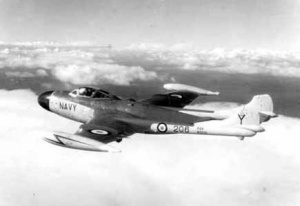
Left: A de Havilland Sea Venom F.A.W. MK 53 on the runway at HMAS Albatross. Right: A Sea Venom launching from the aircraft carrier HMAS Melbourne during the 1960s.
The de Havilland Sea Venom 53 was a British designed and built two-seat fighter all weather (FAW) in service with the Royal Australian Navy (RAN) from 1956 to 1966; replacing the piston engine Hawker Sea Fury. The RAN purchased 39 of these aircraft.
The Sea Venom was the naval version of the Venom NF.2 two-seat night fighter. The necessary modifications for use on board aircraft carriers included folding wings, a tail-hook and a modified and strengthened undercarriage. The 808 Squadron, reformed in the United Kingdom (UK) on 23 August 1955, was the first RAN Squadron to be equipped with Sea Venoms which were formally accepted into RAN service on 27 February 1956. The squadron embarked in HMAS Melbourne, which had recently commissioned and arrived in Australia in April 1956.
Sea Venoms were operated by 805 and 816 Squadrons embarked in Melbourne during exercises in Southeast Asia, while serving as part of the Far East Strategic Reserve. They also operated on escort duties for the fast troop transport HMAS Sydney to Vung Tau Harbour, Vietnam during 1965 and1966. The aircraft’s main role was to provide 24 hour fighter protection for the fleet from enemy aircraft while on operations.
Flying the Sea Venom required significant skill and ability. Two 808 Squadron aircrew were killed in the UK on a training flight in January 1956. A total of 11 of the 39 Sea Venoms crashed or were damaged beyond repair with nine aircrew killed. Most of the crashes were at Nowra but two occurred at sea from Melbourne due to equipment failure. A Sea Venom was lost, with both aircrew killed, on 8 August 1956 when the catapult failed to effectively launch the aircraft. Nearly ten years later (on 28 April 1966) a Sea Venom crashed into the Philippine Sea, with the observer killed, when the tail hook failed on landing and the aircraft lost power; being lost over the side of the carrier. Another was lost off the east coast in May 1959 while on a photo reconnaissance training flight and another crashed into Sydney Harbour, on 5 July 1963, following a collision with another Sea Venom during a flypast.
The Sea Venom began to be to phased out of RAN service in mid-1966 and was replaced by the US McDonnell Douglas A4 Skyhawk, although 724 Squadron operated four as target towing aircraft up until June 1973. A number of Sea Venoms were sold for scrap or used for firefighting training at Nowra. A few became museum exhibits.
Specifications
 |
| Type |
Carrier-borne All-weather Fighter-bomber |
|---|---|
| Manufacturer |
De Havilland Aircraft Co Ltd, UK |
| Number Ordered |
39 |
| First Delivered |
27 February 1956 |
| Length |
36 feet 8 inches |
| Height |
8 feet 6.5 inches |
| Dimensions | Wing span: 42 feet 10 inches |
| Speed | 575 mph |
| Range |
705 miles |
| Crew |
2 |
| Engines | One 5300 lb thrust De Havilland Ghost 105 |
| Performance |
|
| Armament |
Guns: 4 x 20 mm (150 rounds per gun), Bombs: 8 x 60 lb rockets |
| Ships embarked in | HMAS Melbourne (II) |